Last week I led a bamboo building workshop with a friend and fellow permaculturist at a Technical Institute for highschool students in the Volta Region of Ghana. This area is about a 4 to 5 hour drive from where I live and in a very green mountainous part of the country. It was great to get away from the grind of work for a few days and work with my hands, see another part of the country and experience some cool rainy weather.

I ended up leading the whole workshop basically. I am no expert in bamboo building though I have dabbled in it in a few projects and have some basics. But this was a good way to learn more and challenge myself and the other participants. The scope was to build 2 pavilion spaces right next to each other on the school grounds to serve as a mixed use space. The school can use the pavilion for classes, dinning hall, or study area.
My friend who put this together I met him 4 years back at a Global Ecovillage network training event. He did a 28 day program on Eco-village design. The Global ecovillage network is a basically that a network between eco-villages and projects world wide. The challenge would be to do all of this in one day and build using no nails.
We planned to have the training on one day we scheduled this for the 21st because it is a holiday commemorating Ghana's first president Kwame Nkrumah that father of pan-Africanism. So it was a good day for people to get together to learn an indigenous skill that uses local African resources. It meant that I would use one day for traveling there, one day with him preparing and then one day to travel back so a total of 4 days.
Day 1: Traveling to the Volta Region
The first day was the travel day and that was last Monday. We left the beach resort about 10am and drove into Accra to the East. We stopped at a super market for snacks and then we drove straight through Accra and out the far other side of the city to the east.
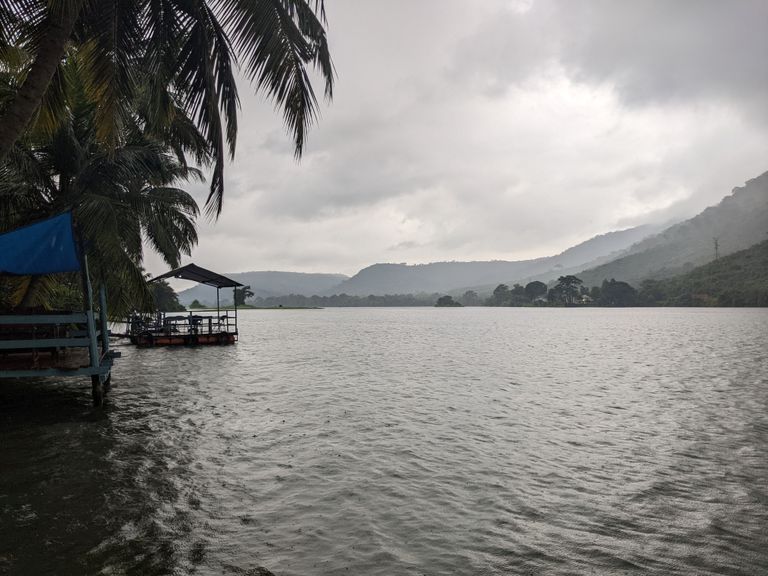
It was a cool rainy day which made traveling nice. I was driving a company car that was recently given to me and it is about a 12 year old Nisan Patrol 4x4 which meant that I did not have to worry about any car problems along the way vs. my old VW transporter truck which would have added another element of stress to the journey.
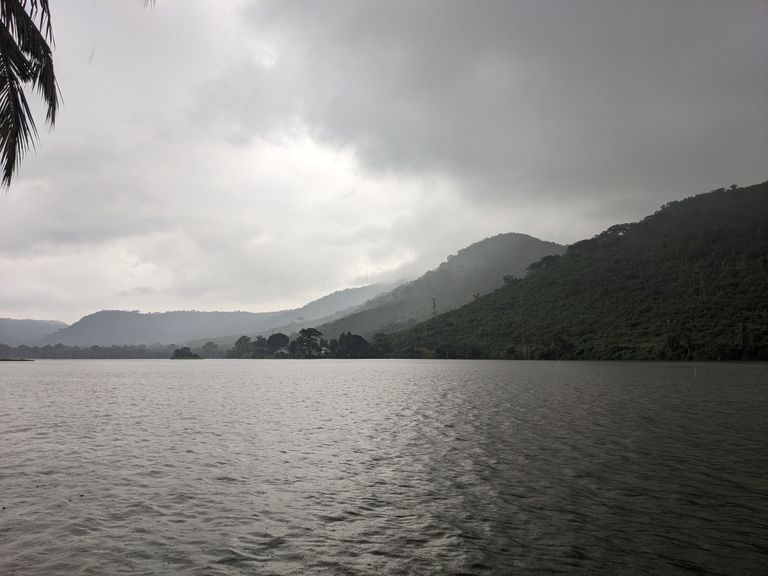
About 20km after getting out of the city and into the rural areas the road goes along Shai Hills Reserve which is most notable for its packs of Baboons which are often along the road side.
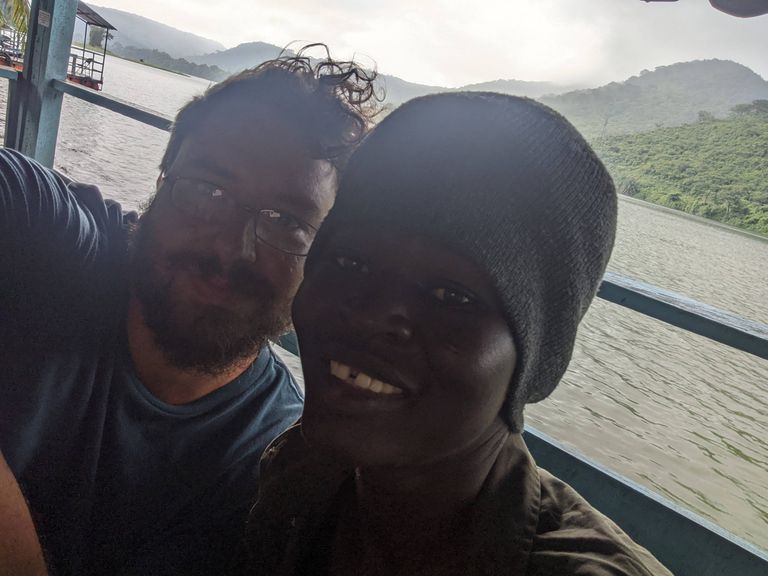
Our first stop was about 2 hours out of Accra at at place on the Volta River called Aylos Bay. We stopped there for dinner. It is right below the Akosombo dam which was the dam for the worlds largest man made reservoir until 3 Gorges Dam was built in China. We had a nice lunch at the side of the river before we got back on the road.
We crossed the river and drove into the Volta region. We drove along a mountain side that was cut off at the top by fog and mist with green beautiful jungles on the sides of the mountains. We eventually got to the regional capital Ho. From there I called my friend to see where I would meet him and he gave me directions to the fathers house.
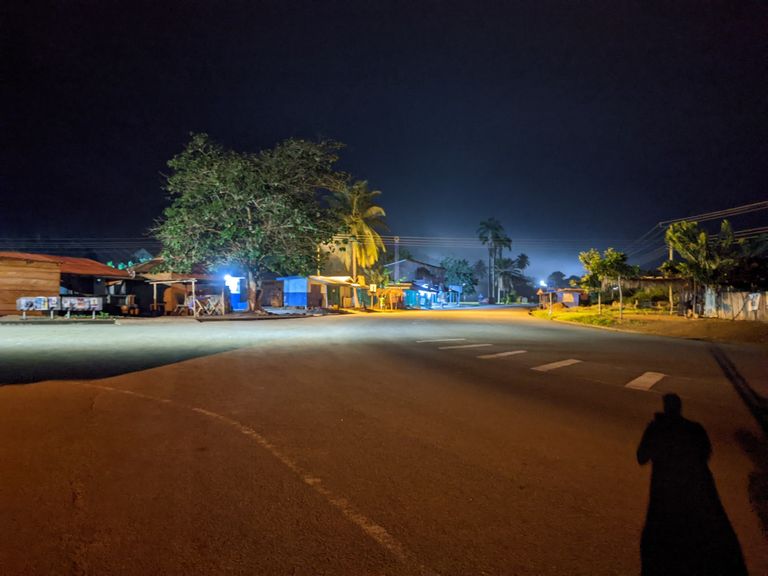
To get there we had to drive up a road that went up the mountain to the north of the city and then we went through 2 villages before we reached Matse. His fathers house was on the main road not long after entering the village. He was still at the farm so we waited for him to return. We arrived at 5:30pm so it was just another hour until it was dark.

We went for a little walk and a beer after going back to Ho to get some food. The surroundings were cool and rainy with mist on the mountains that surrounded the whole little valley. Some of the scenery could even look like a village in Europe.
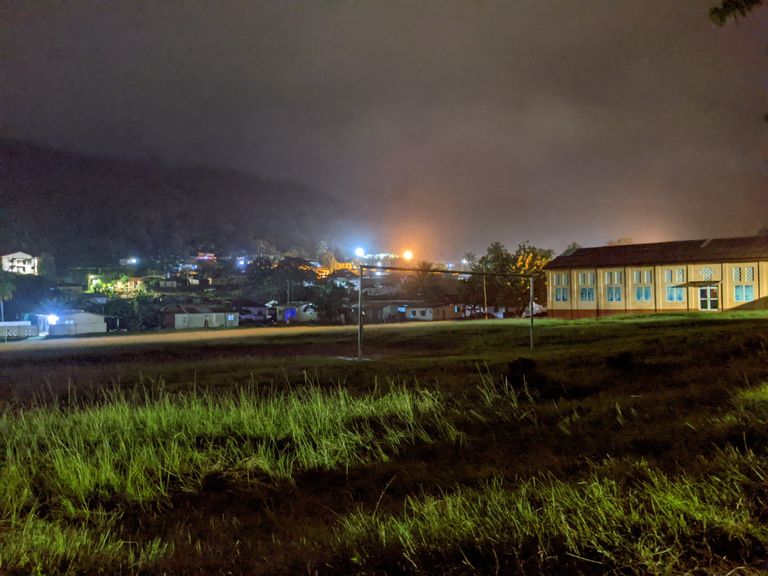
I think you can finally see an outline of the mountain in this picture that were just dark big objects in the not so far distance.
Day 2: Preparation day
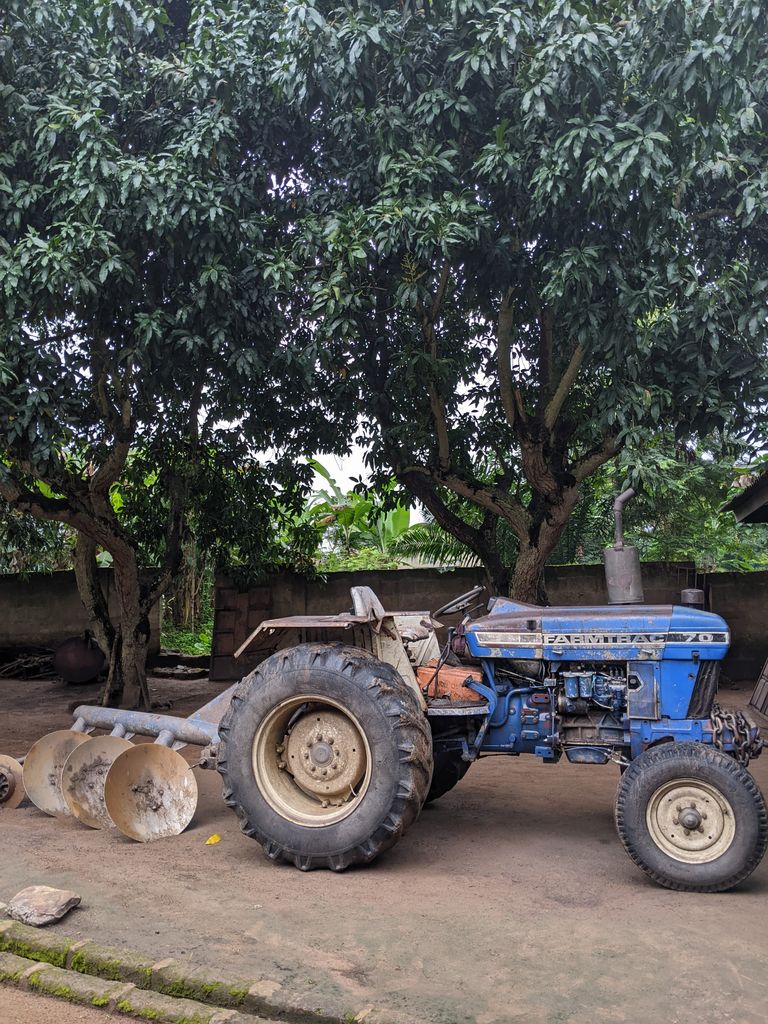
We got a relatively early start. We got to the school to check out the building location around 8am and met with the assistant head master. We passed out the rough footprint of the structure, it will be two side to side structures with 16 feet by 32 feet at the foot print with 8 foot spans between teak posts with a slanting roof taller at the front lower at the back. We had a couple of challenges. One the land slanted from one side of the structure to the other, we also had limited lengths in the teak pools with the longest being about 13 feet. In Ghana there is no real standard about what standard of measurement to use, metric and imperial are both used. Sometimes I still find it easier to think in imperial so I just went with that.
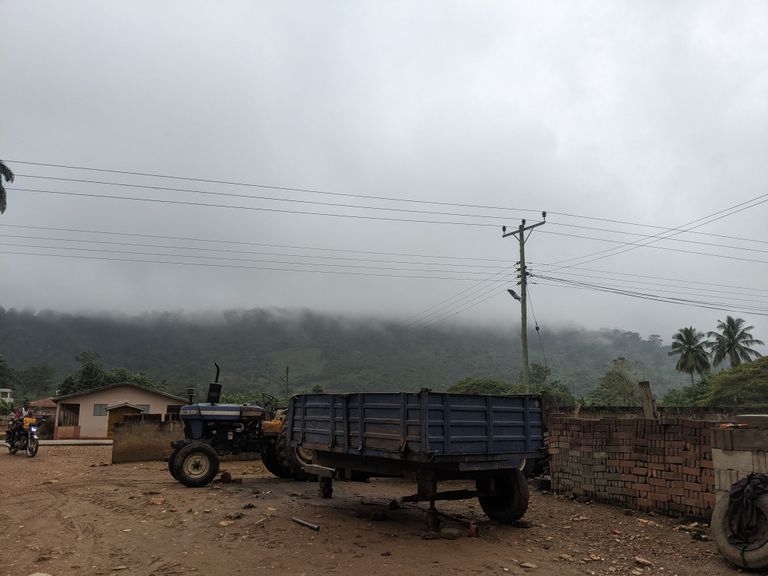
The school was about a 5 minute drive from the house just out of town after leaving the mountain valley to a larger valley below and the school is on the side of a mountain. There are about 300 high school aged students there learning different technical skills building included. We then learned in that morning meeting that we were to expect at least 100 students. We were also planning to have up to 10 paying participants and another 10 community members. This caused a little stress because 1 we needed to figure out how to effectively lead 100 students and then we needed to make sure we had tools and something for them all to do and lastly we had to have a snack and a drink for all of them.
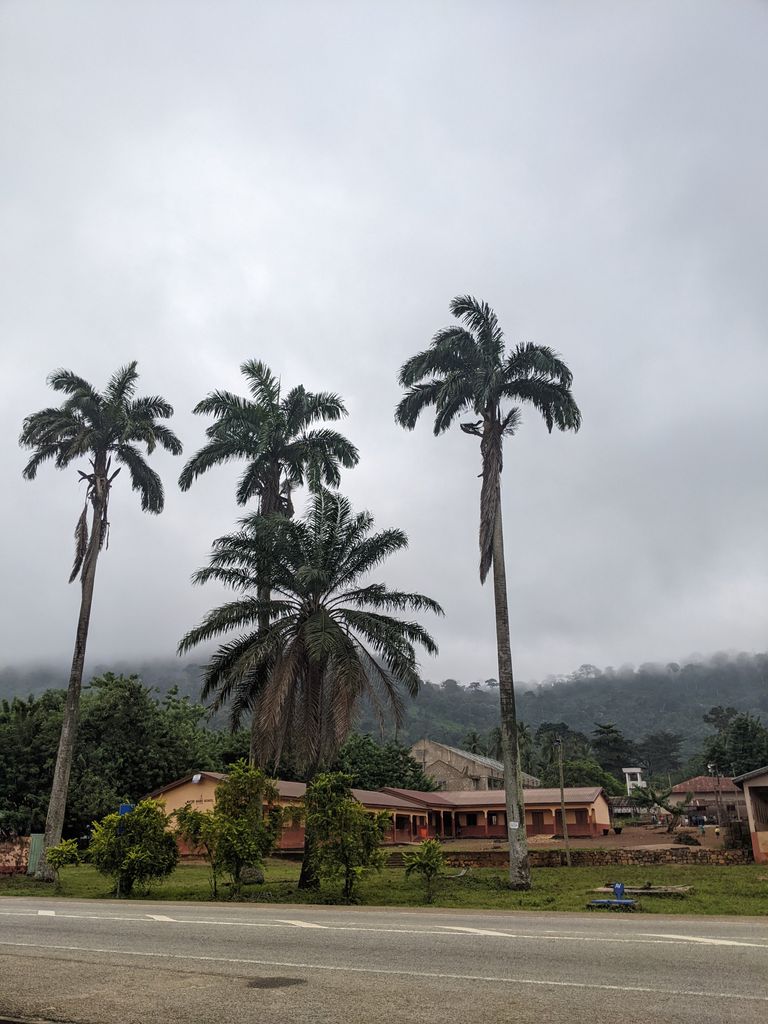
After getting a better idea of what we had got ourselves into we had a number of things to do that day. But one of the first was that my friend had his partner come in from Accra who he is working on a 5 acre food forest with. This is along side his dads farm which is closet to 300 acres of primarily oil palms. The best way to reach the farm from the village is to take the tractor path, but this was impassible with any car at the moment because of the rain and mud.
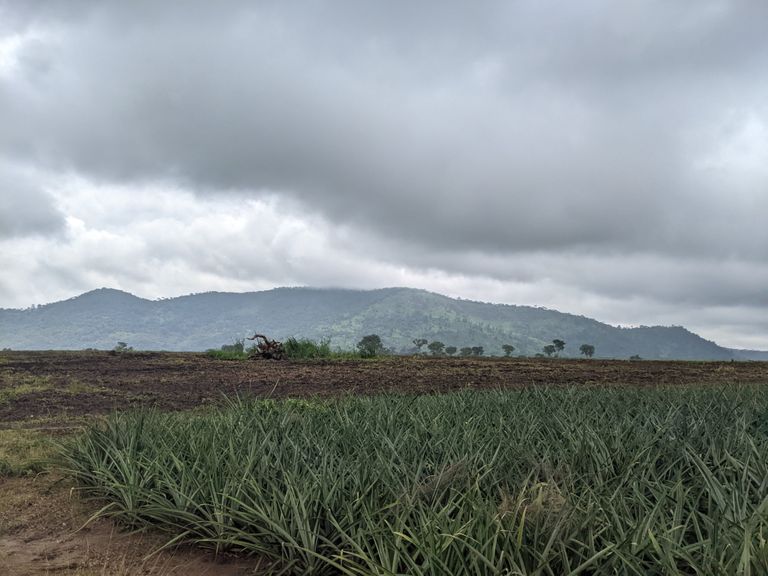
We needed to take a little bit longer round about way. To do this we back tracked on the main road back toward Ho and took another road down out of the mountains into a large valley floor. My fried missed a turn and we went about 30 minutes in the wrong direction. We eventually had to go back and get the correct turn we then took a road that went along the base of the mountains. And the notable land mark that we used was a very large pineapple plantation that primarily is for export.

The 5 acre food forest they are working on planting is up close to the mountain and tree line.
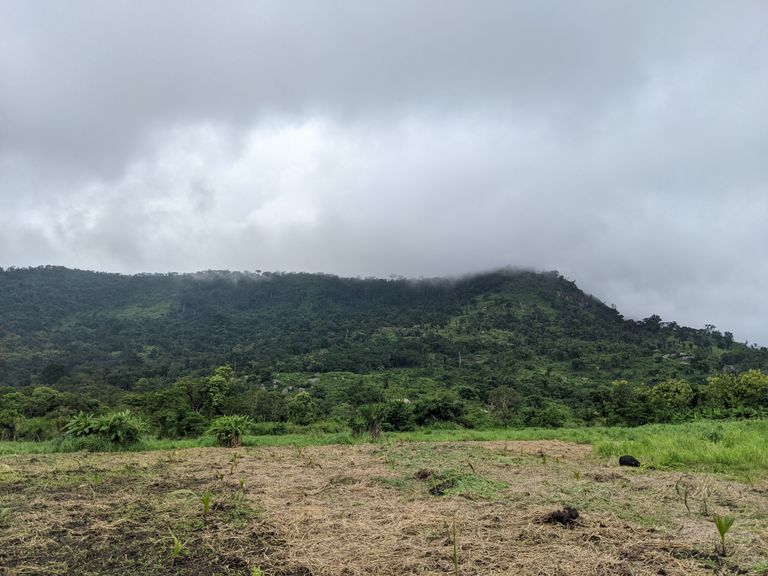
Currently he has done a lot of weeding and planting of coconut palms, plantain and some avacado. He will then plant other crops in the rows between.
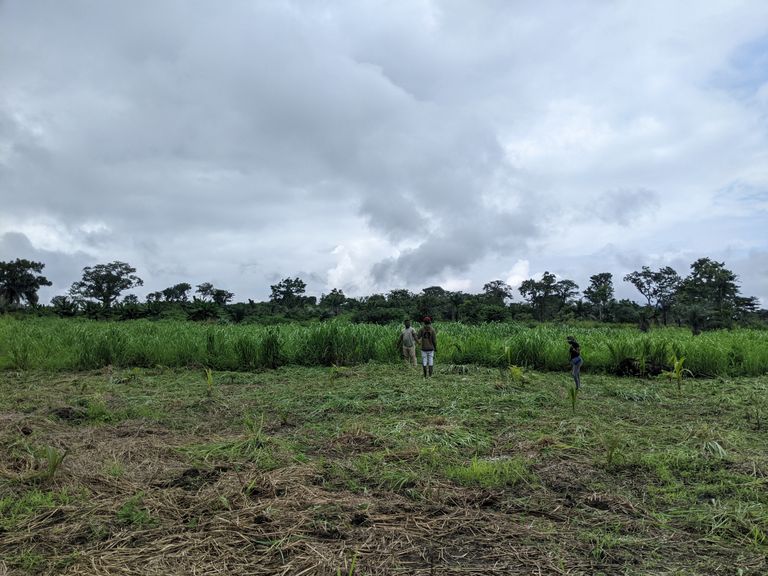

From the farm it was time to go back to the school get some prep work done and map out or work plan.
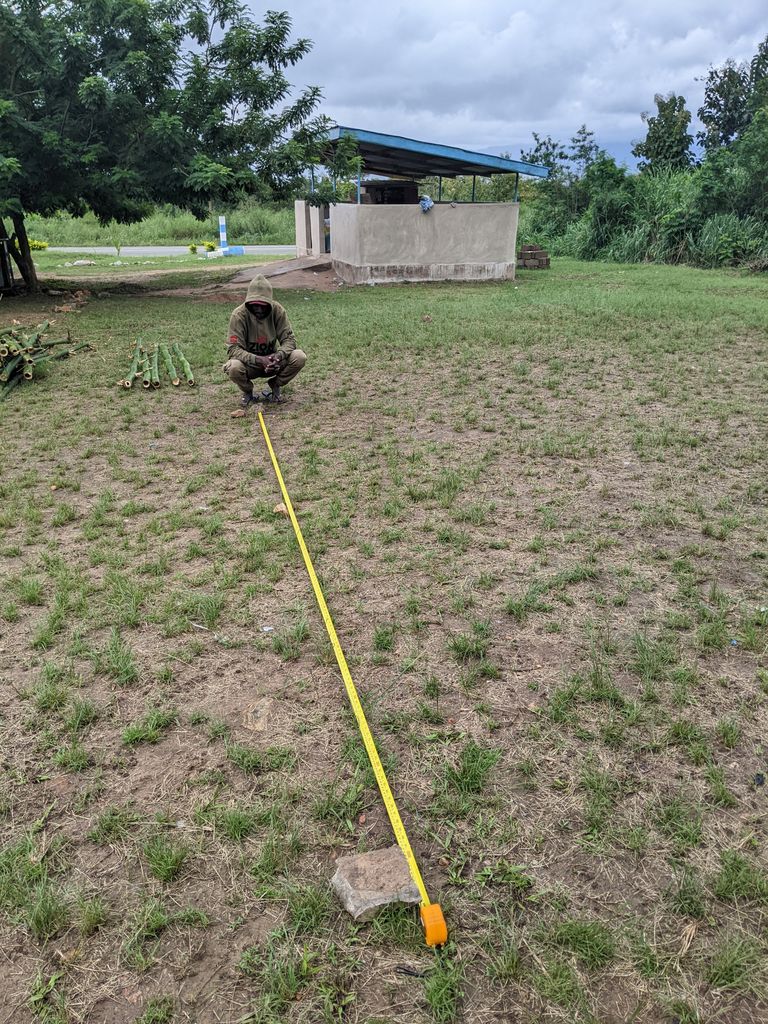
Dom and I measured out the floor plan and placed stones where each of the 12 teak poles would be. We were using teak as it will be buried in the ground and in contact with termites and moisture which bamboo does not get along well with. The teak and bamboo will all harvested out of the surrounding mountains and are quite plentiful.
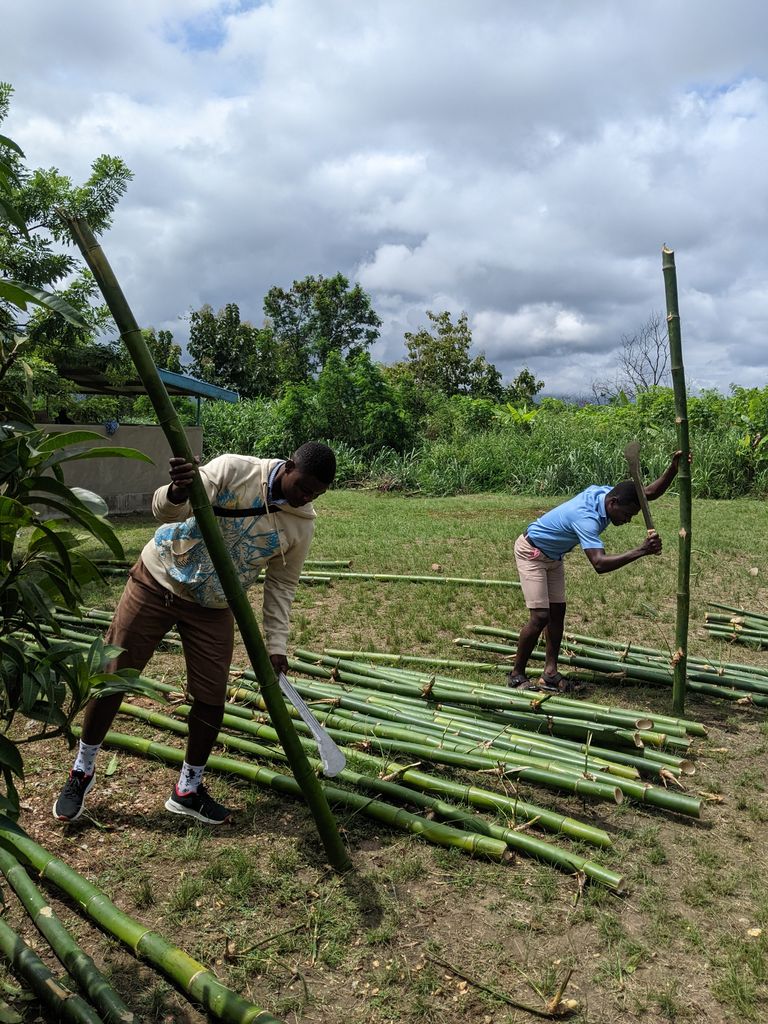
We got some students with machetes to clean up the bamboo a bit. Dom and I then sorted them into various lengths and sizes. We were doing things in 8 foot sections so we needed about 40 of those lengths. We needed some 16 foot spans for a couple of the long sections. Then we decided to do the side panels and roof in modules that the students would build and then we would attach them to the main structure.
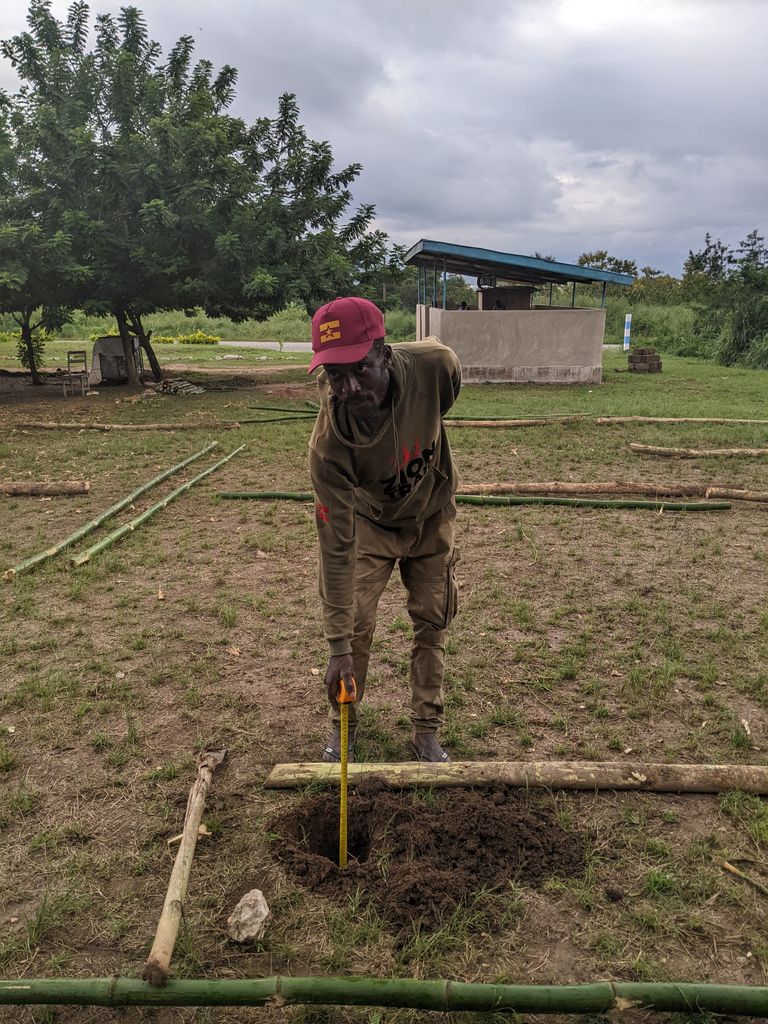
We then dug the holes and put the teak posts in the holes.
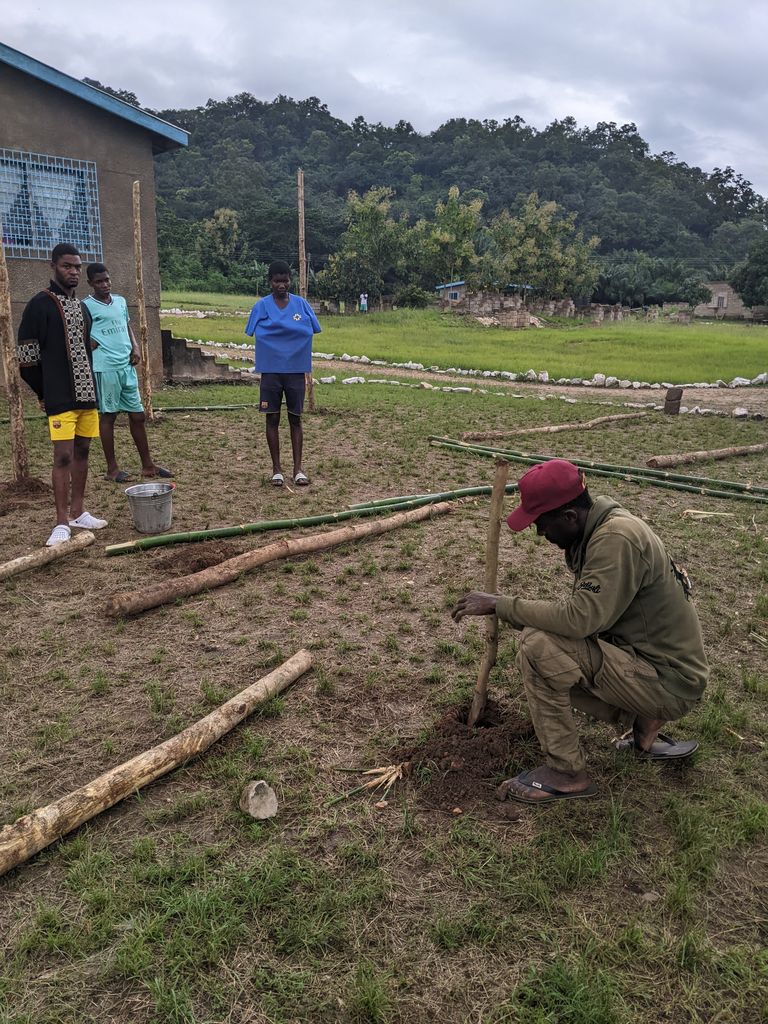
We got most of the holes dug and posts sunk but there were some stubborn areas and we pored some water in them and let them to soak and asked the students to finish those holes later.
We then had to go to Ho to sort out some of the snacks and drinks for the next day and get some food. We then went to bed and got an early start in the morning.
Day 3: Training Day
In the morning we still needed some more bamboo delivered and prep things. We would start at 10am. I went the school on my own and got started because Dom needed to go to Ho to get the snacks and get started on those because his auntie who was going to help with that was sick that morning. The prep went on well and I had most things ready many of the students had already started to gather around though. I finally gathered them at 10am and gave them an intro about bamboo, why it was a good resource to use and why many had turned their back on it seeing it as a old fashion thing. I them briefed them on the construction and broke them down into 4 teams to build different parts of the structure.

Two teams build the side railing pieces. These modules consisted of two 8 foot section that would be split and then sandwich 4 foot sections that had been split in 4 pieces. They were then lashed together using hemp rope. The first challenge materialized quickly with this as it was clear that the rope was not going to be enough. We needed 11 of these panel we ended up getting 9 with the materials we had and switching to a nylon rope.
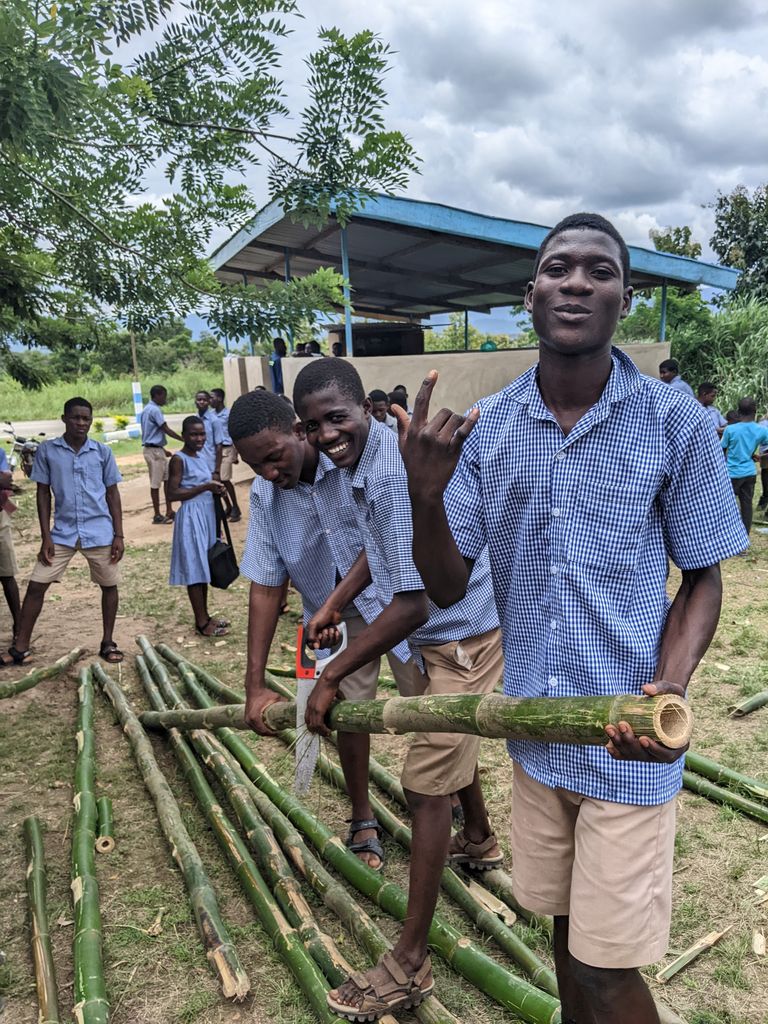
The other two teams build roof modules. We were doing a simple split bamboo roof pattern that was built on 8 foot by 4 foot sections again.
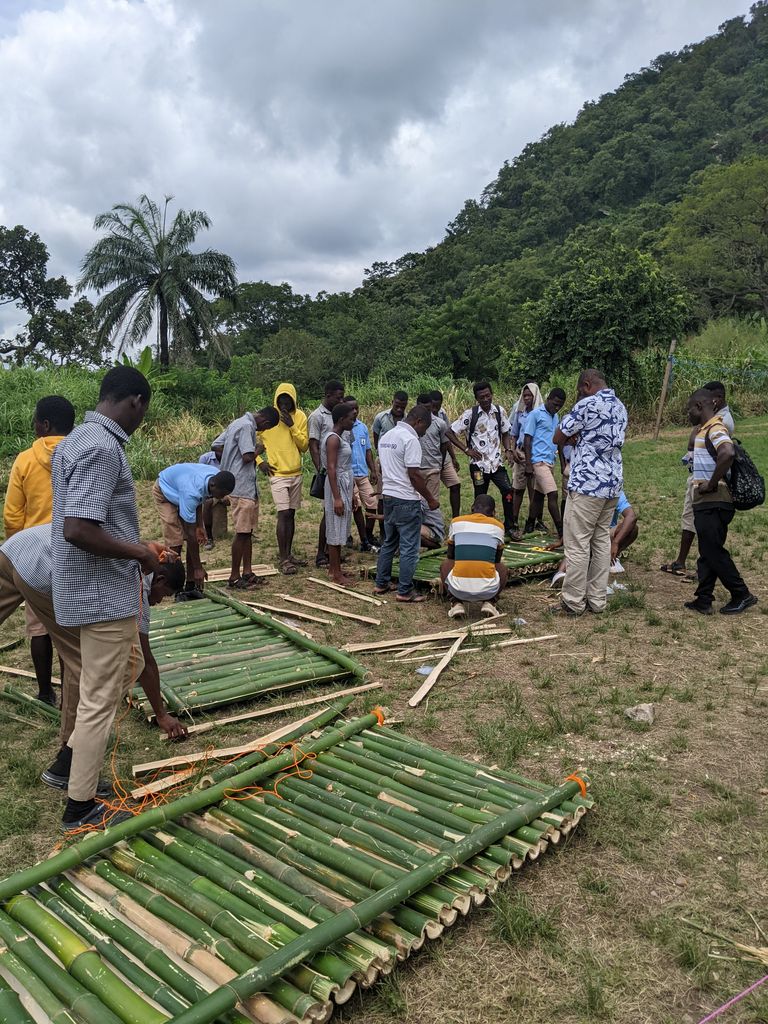
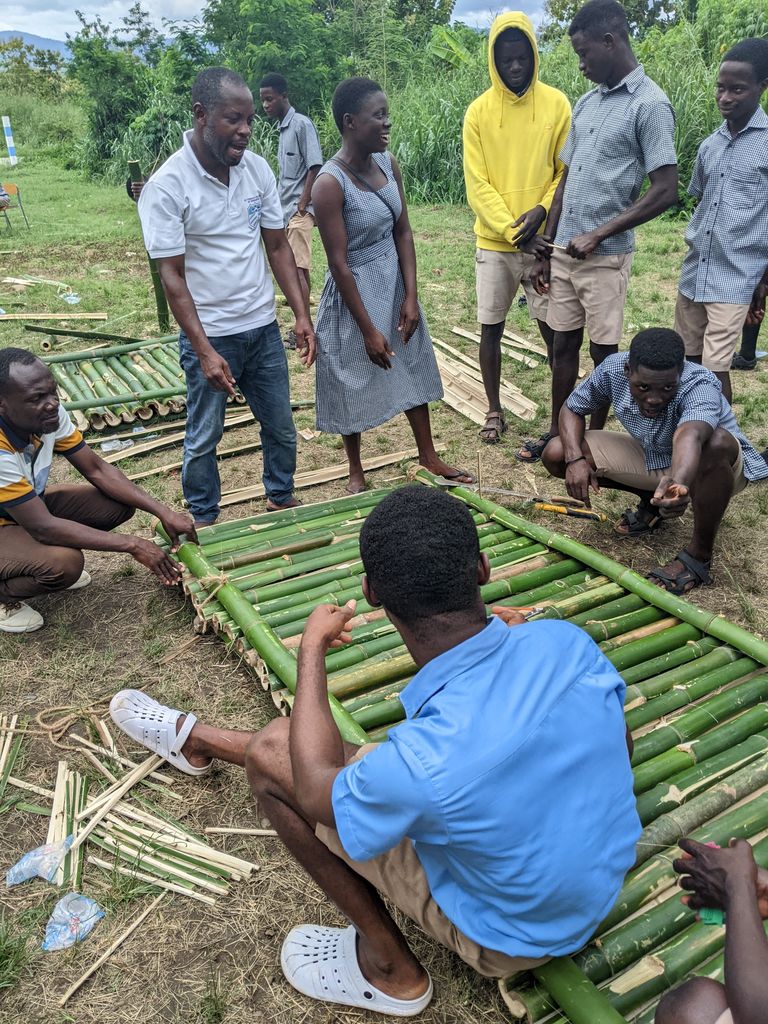
Each team built their pieces a little differently quality was all over the board. This would come back and haunt us a bit when it was time to put things together. These roof panels also became quite heavy. Like I said though sometimes we learn best through teaching and if I were to do it again I would do things differently.
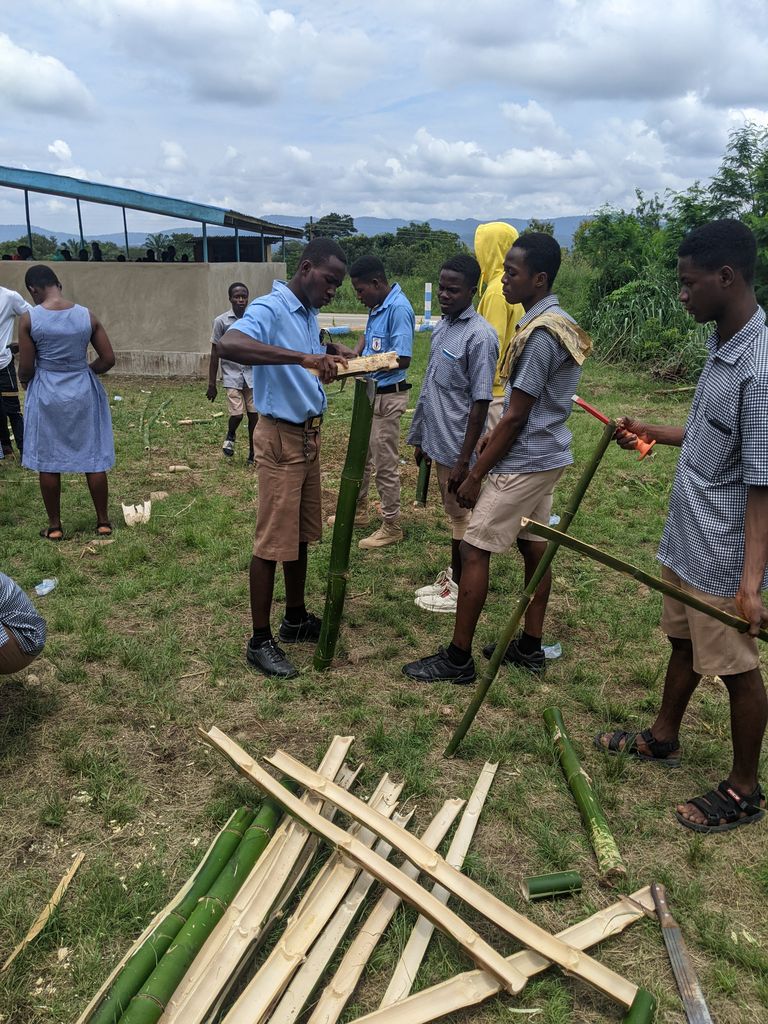
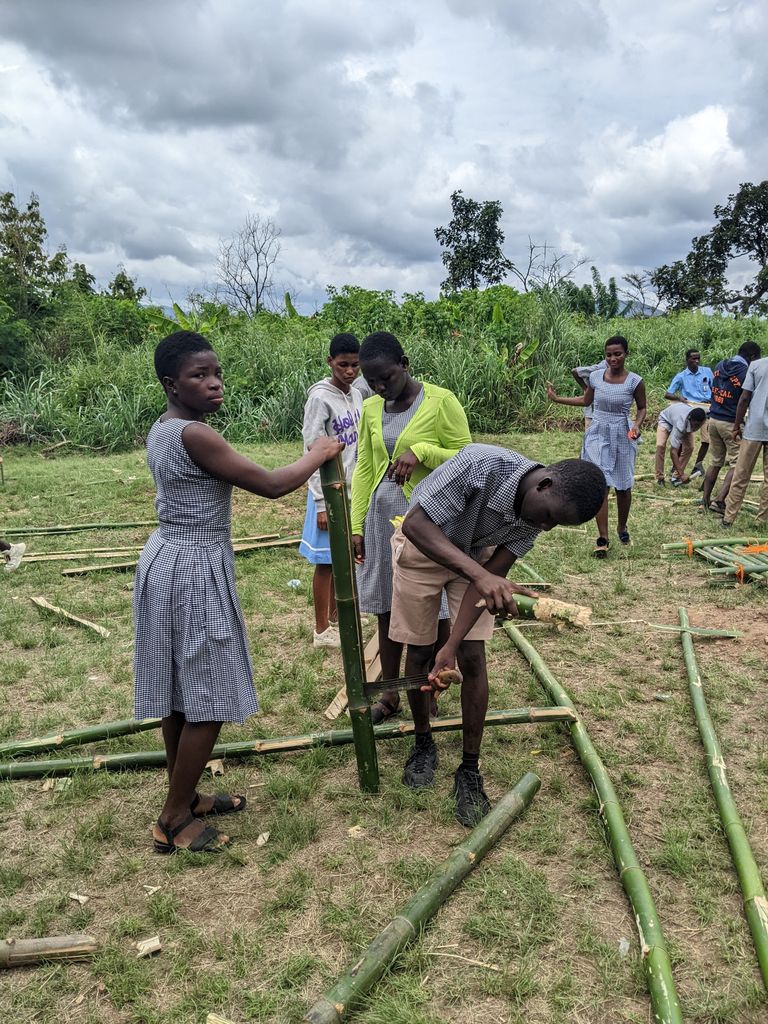
The students were all eager though and they all participated. At first the head master did not think that the girls would be too involved in the building process but I encouraged him to let the join each of the groups like everyone else. I tried to get some pictures of them cooperating and taking lead too.

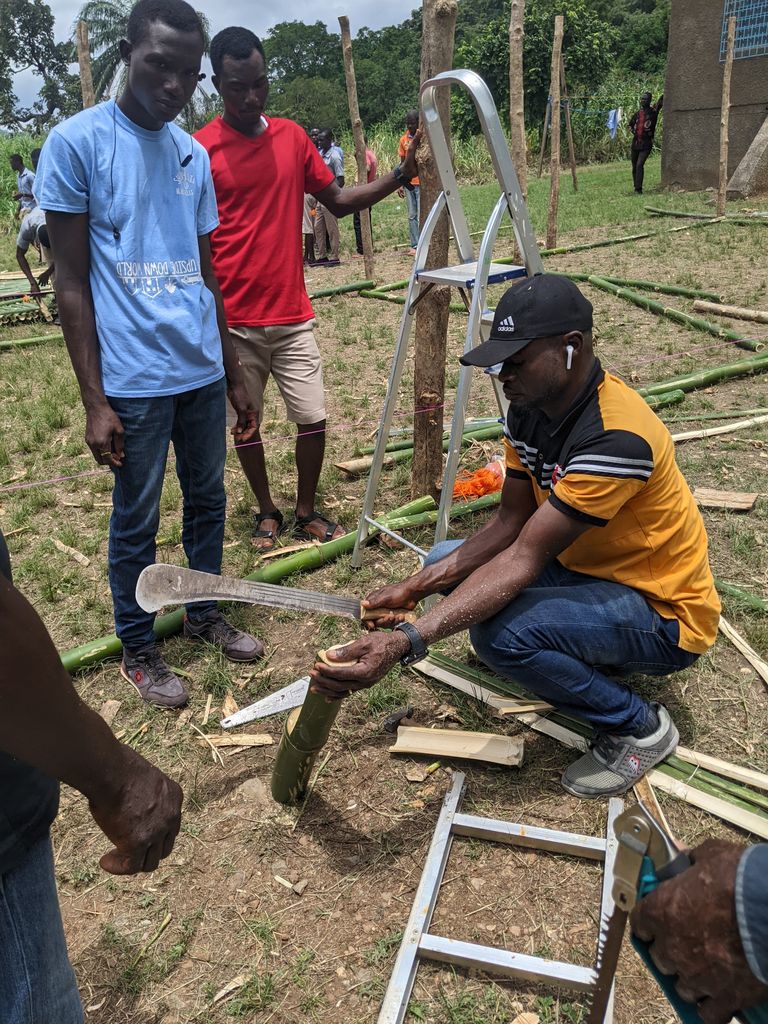
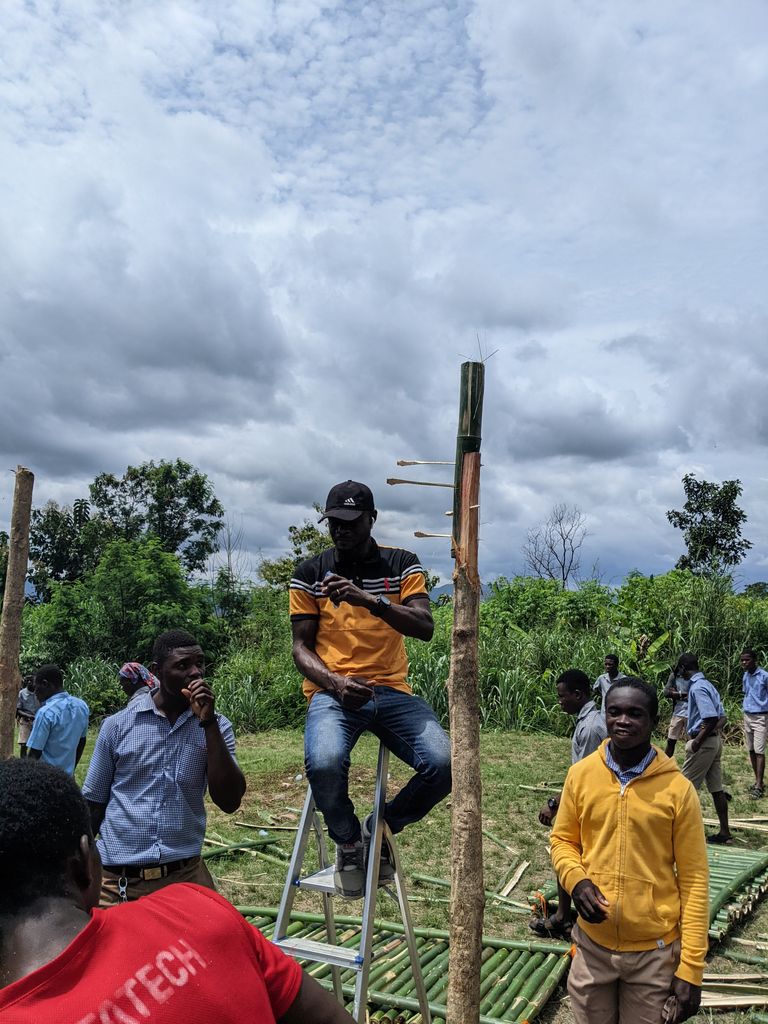
Like I said before one of the challenges of the build was that the teak poles came in limited lengths. After placing them all and putting a level line around the bottom of the poles to measure against some of them were too short. My solution was to lengthen them by grafting bamboo to them. With my inspiration and the building teacher and a carpenter we came up with a solution that merged the two well using a cut joint and bamboo pins.
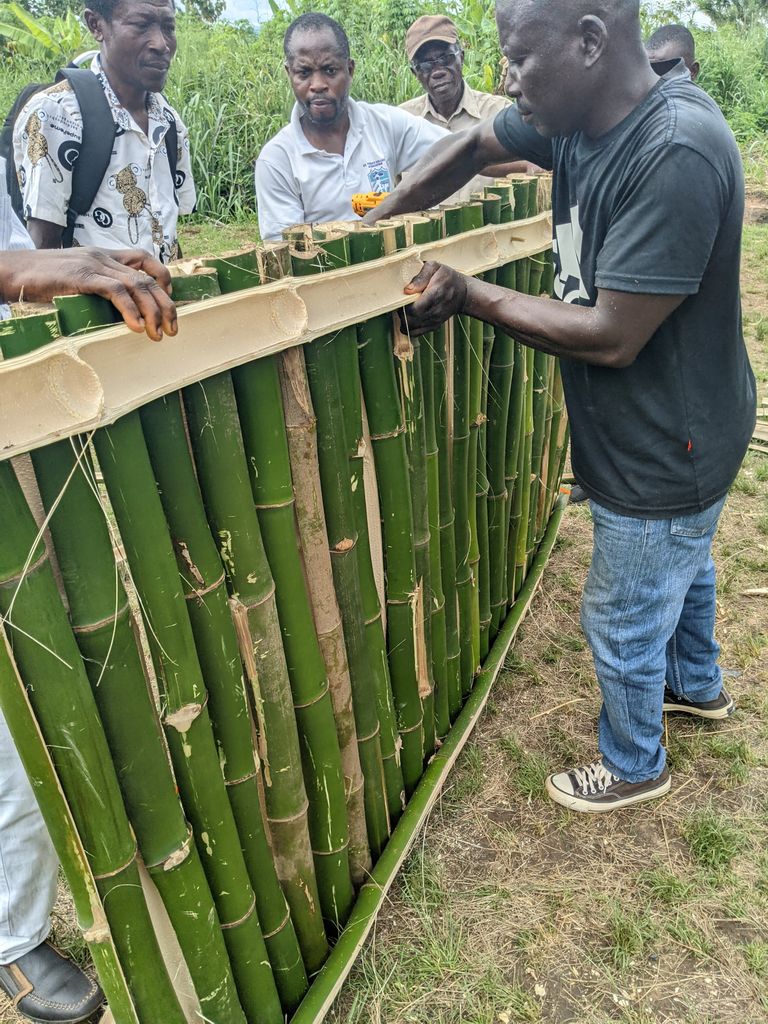
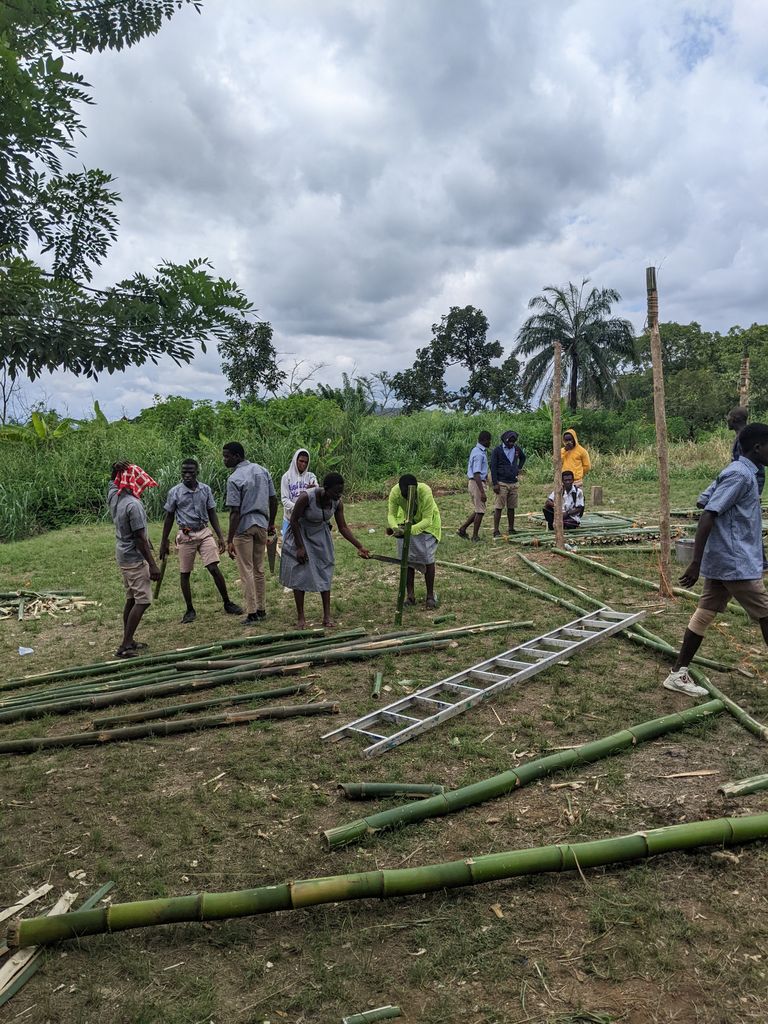
Just a few more action shots.
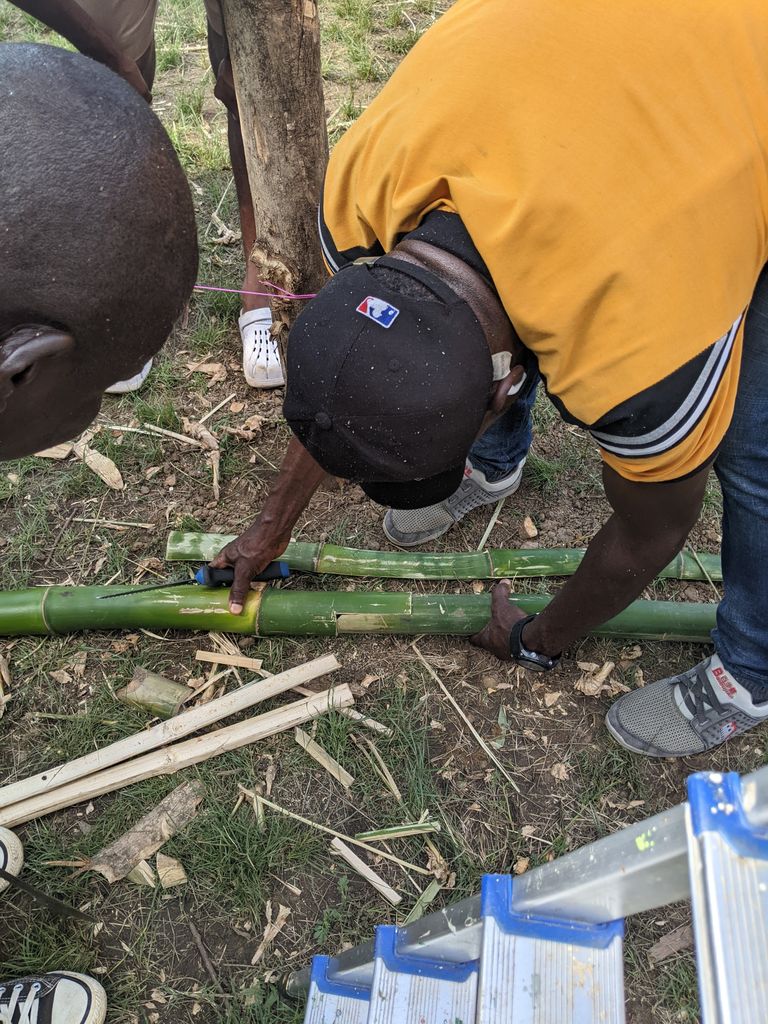
When it came time to do the cross pieces on the roof we did a joint that merged two 16 foot sections to span the whole 32 foot length of the building.
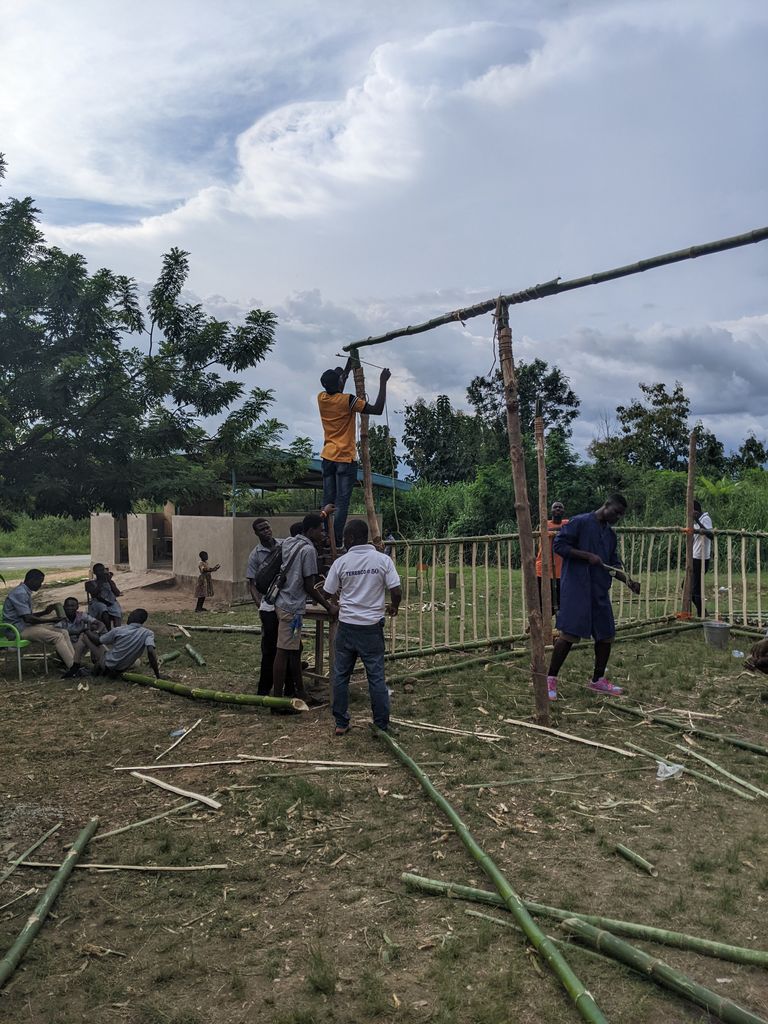
The first cross beam section being tied to the top.
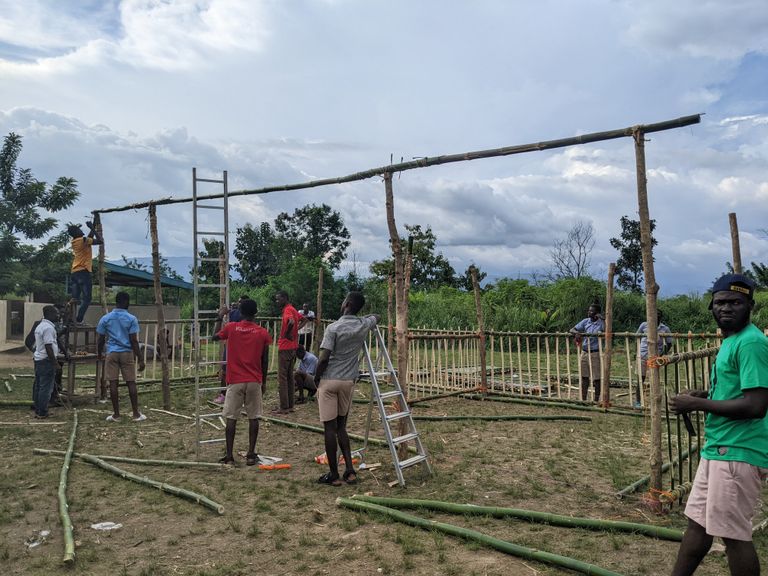
Finishing the knots in the first cross beam section.
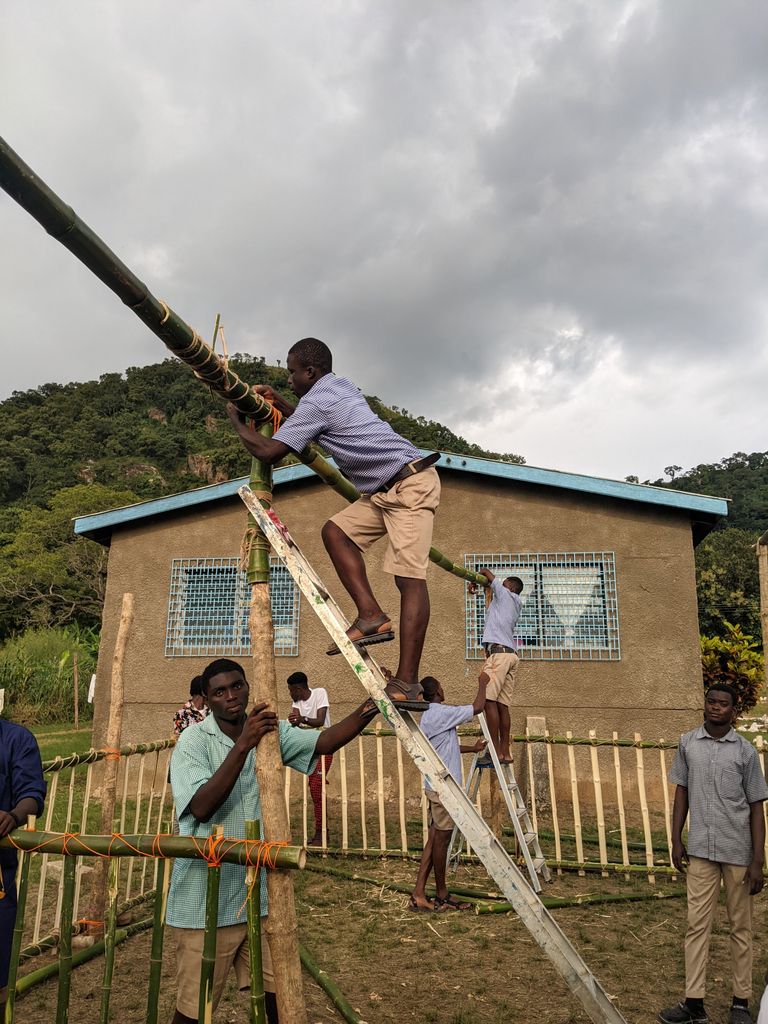
The second one went up as smooth as the first and we had the students do more of this one.
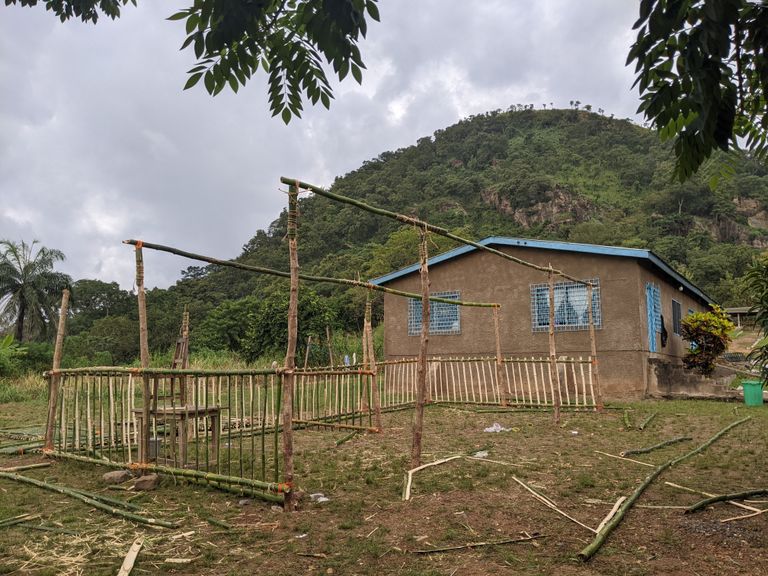
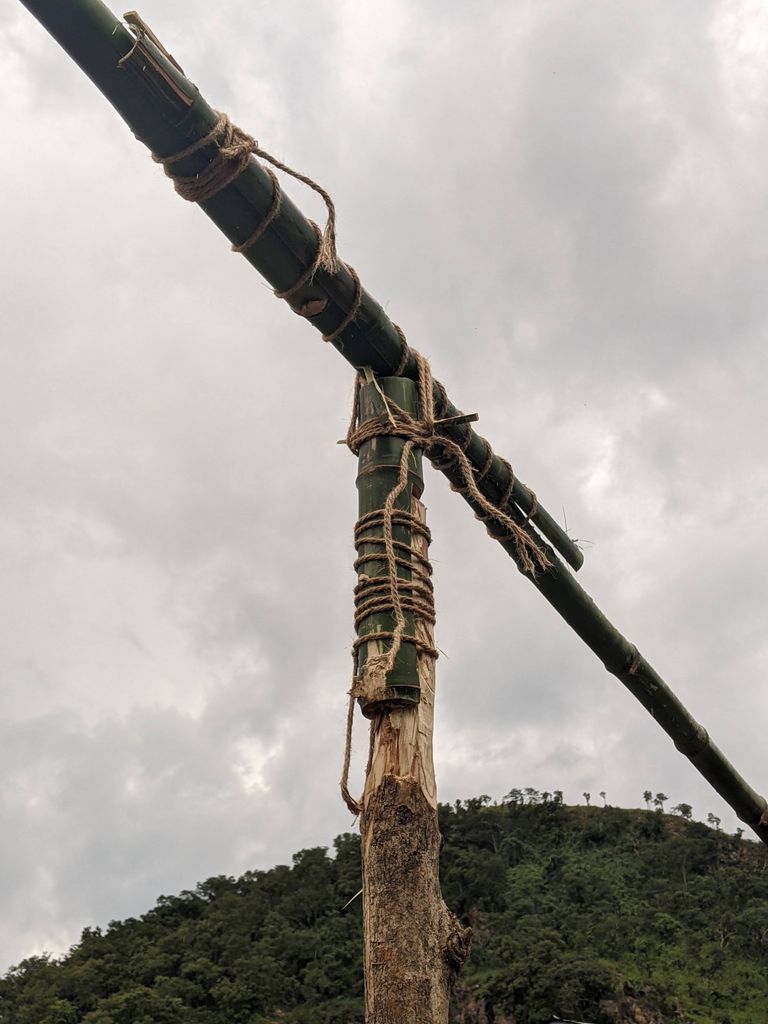
At about this time the batteries in the drill were dead and we had run out of steam in general at the end of the day. This is where we ended with two cross links up and the third yet to be completed. This was the end of the official training but we agreed to come early the next morning to put up the four roof panels that the students were able to complete with the bamboo we had on hand.
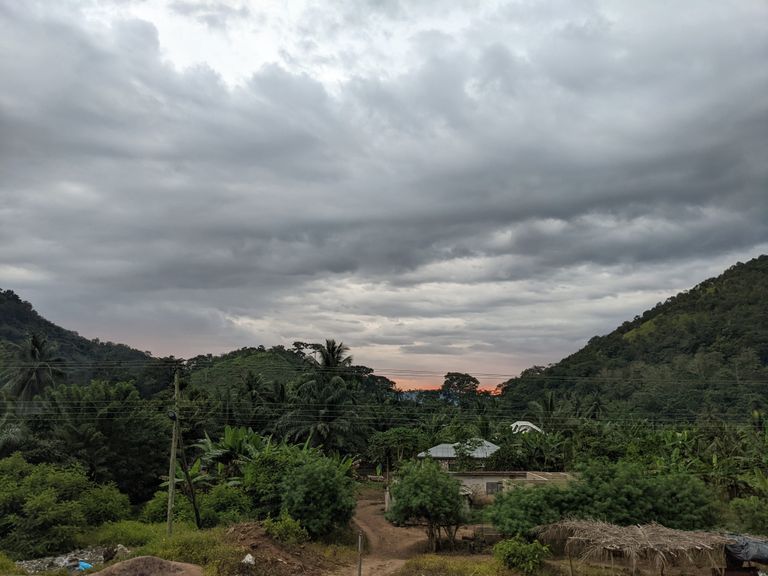
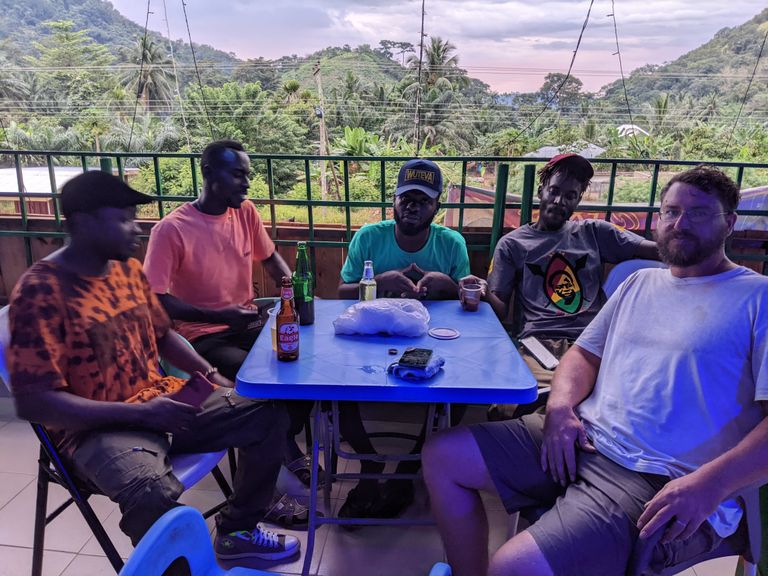
My friend and I and a couple of the community voluteers retired near a rooftop bar that evening to watch a sunset.
Day 4: Finish up and head home
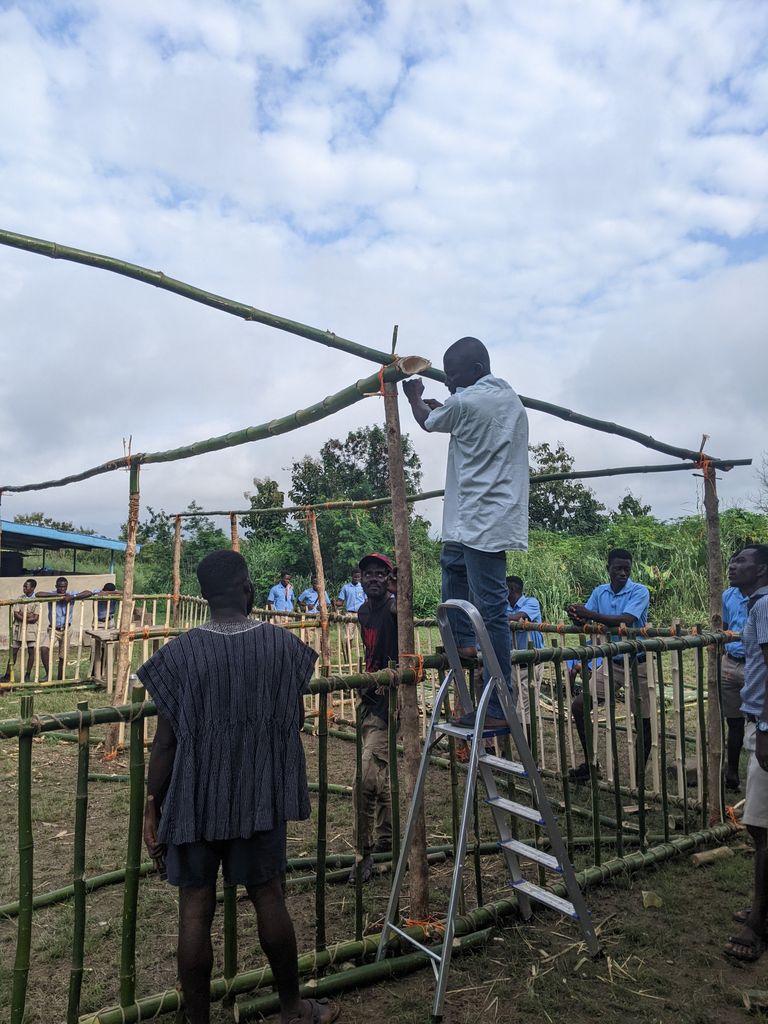
The next morning I think we got going around 7:30 and went to complete the cross beams and then the rafters.

We then attempted to raise our first roof section but it fell apart as we did so the slats were just sliding out the bottom of the module so we had to rebuild some and add a cap at the bottom to hold them in and keep them from sliding out.
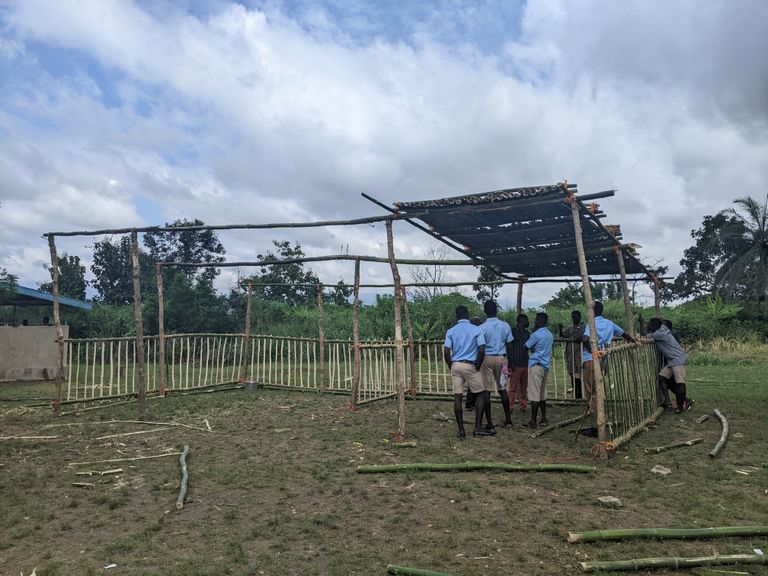
By about 9:30am we completed the roof section that we had materials for. We then briefed the school on some ideas of how they could finish it and how we could help them get more bamboo. I suggested that they use long spans of split bamboo to finish the roof rather than the modules we did in the demonstration. They are due to finish in the next week and I will hope to have some more photos by then. I learned a lot, the school was very appreciative and I think the students learned a lot also.
From there we got in the car and made the trip home. It was a great escape and my wife at 8 months pregnant said it was exactly what she needed also.
Thanks for checking it all out.
Bamboo is a very good material for building a structure and it is also easier or faster to grow, however the bamboo wood must be treated because in the long run it will get damaged by burrowing insects.
Yes very true and part of what I talked about in the intro. Treatment is still not prelent in Ghana there are very few places that have the setup to do this. One friend who has done most of his resort with bamboo gets it after it has floated down a river for 3 days, this has removed most of the cellulose and sugars which is what is attractive to these bugs.
Yes I forgot about that, in the old times they would soak the bamboo in a body of water like under the beach for a couple of years to make more resistant against insect infestation.
This Bamboo pipe organ in Las Piñas Philippines was made that way, it was created from between 1797 and 1819 and is till used until this day.
Thats cool, thanks for sharing.
:::Discord :::Whatsapp:::Twitter :::
Great post!!!
Thank you, hope things are well with you and your projects.
Yes, everything is fine. My problem is the time....
The only thing we can't get more of.
It is a pleasure for us to share our best wishes and congratulations. You have been given a virtual hug by the curation account @newvisionlife and manually curation by @OneRay.
You can also use our hashtag #newvisionlife
Es un placer para nosotros compartir nuestros mejores deseos y felicitaciones. Usted ha recibido un abrazo virtual de la cuenta de curación @newvisionlife y curado manualmente por @OneRay
También puedes utilizar nuestra etiqueta #newvisionlife
Your post and blog is always awesome.
Congratulations, your post has been curated by @dsc-r2cornell. You can use the tag #R2cornell. Also, find us on Discord
Felicitaciones, su publicación ha sido votada por @ dsc-r2cornell. Puedes usar el tag #R2cornell. También, nos puedes encontrar en Discord
Very nice sea and also very beautiful photos your post is also high
Congratulations, your post has been curated by @techclub
Manually curated by
@samhenrytenplus
Your post is very attractive all time. You try to share a lot of photographs and you also add suitable sentences to make the blog so interesting. To check out your blog is nice feeling.
Congratulations your post has been curated by @blurt-india .
Support our couration account by delegating some of your blurt power to blurt-india and make it stronger